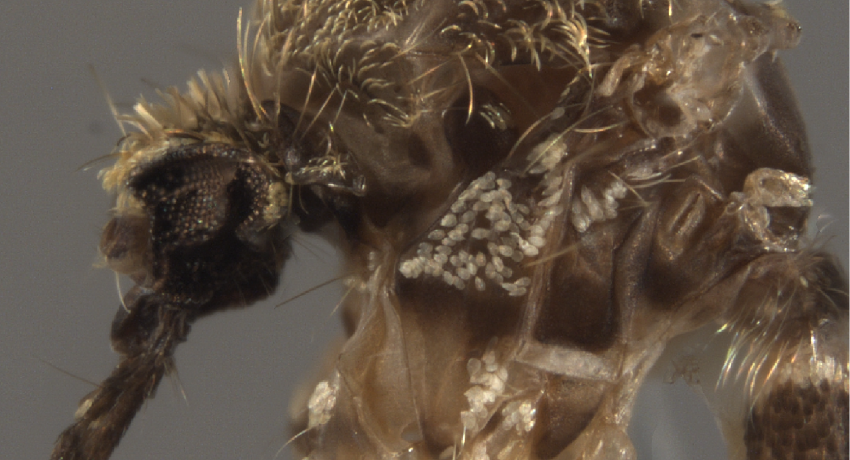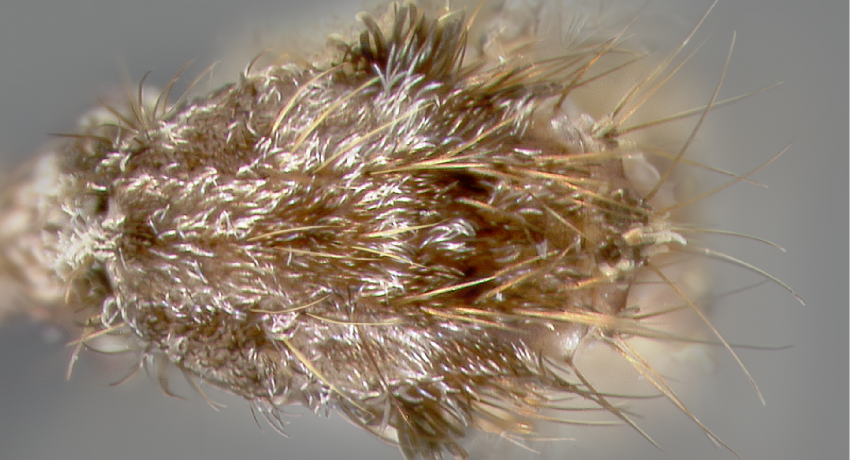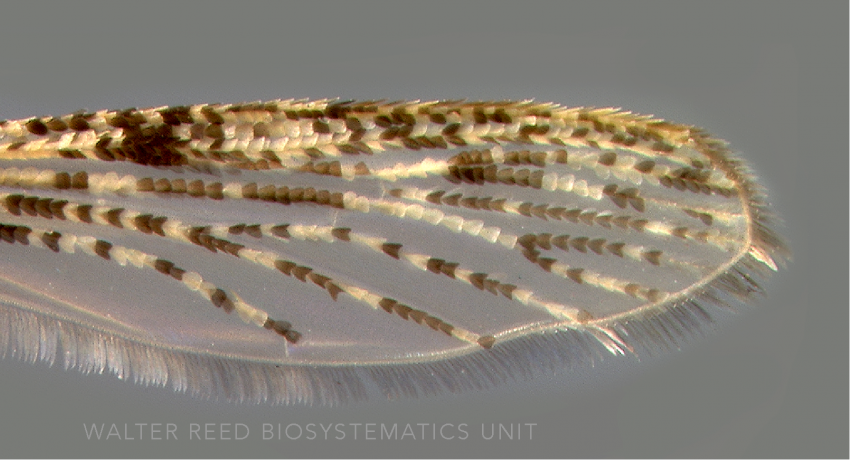AFROTROPICAL, AUSTRALASIAN AND ORIENTAL REGIONS
Generic abbreviation: Mi.
Type species: Mimomyia splendens Theobald
Etymology: not stated [mimo- imitator, actor plus small fly (Gr)]
Together with those in the genus Ficalbia, species of the very tiny Mimomyia mosquitoes comprise the tribe Ficalbiini. The genus Mimomyia (45 species) is subdivided into three subgenera. Subgenus Etorleptiomyia (seven species) is found in the Australasian, Oriental and Afrotropical regions; subgenus Ingramia (21 species) is reported from Madagascar and surrounding islands, and the Oriental region; and subgenus Mimomyia (17 species) is found in the Afrotropical, Australasian, and Oriental regions. Mimomyia (Mim.) chamberlaini has three valid subspecies: chamberlaini Ludlow, clavipalpus (Theobald) and metallica (Leicester).
DIAGNOSTIC CHARACTERS (Click photos to view; mouse over and click large photo to zoom in.)
ADULT (illustrated): Head: Erect scales on vertex and occiput, or only on occiput. Thorax: Acrostichal and dorsocentral setae present. Wing: Alula bare or with broad decumbent scales dorsally; upper calypter with setae or slender, hair-like scales; vein 1A terminates beyond level of mediocubital crossvein. Leg: Pulvillus absent or indistinct.
LARVA (not illustrated): Head: Distal part of antenna articulated. Thorax: Setae 9–12-M,T often on prominent tubercles; seta 12-I present. Terminal segments: Siphon usually sharply narrowed distally, sometimes modified for piercing plants; siphon with a single pair of subventral setae (1-S); seta 4-X with 4–6 setal pairs; pecten absent, or reduced to ≤ 4 spines.
TAXONOMIC KEYS
Belkin 1962 (South Pacific)
Edwards 1941 (Afrotropics)
Grjebine 1986 (Madagascar)
Hopkins 1952 (Afrotropics)
Lee et al. 1988 (Australasia)
Mattingly & Grjebine 1958 (as subgenus Mimomyia of genus Ficalbia)
Rattanarithikul & Harrison et al. 2005 (Thailand)
Rattanarithikul et al. 2006a (Thailand)
Service 1990 (Afrotropics)
Tanaka et al. 1979 (Japan)
![]()
WRBU – Genera – Global – Larva
![]()
WRBU – Genera – Afrotropical – Adult
![]()
WRBU – Genera – Afrotropical – Larva
![]()
WRBU – Genera – Australasian – Adult
![]()
WRBU – Genera – Australasian – Larva
![]()
WRBU – Genera – IndoMalayan – Adult
![]()
WRBU – Genera – IndoMalayan – Larva
![]()
WRBU – Genera – Oriental – Adult
![]()
WRBU – Genera – Oriental – Larva
![]()
WRBU – Genera – Eastern Palearctic – Adult
![]()
WRBU – Genera – Eastern Palearctic – Larva
![]()
WRBU – Genera – Western Palearctic – Adult
![]()
WRBU – Genera – Western Palearctic – Larva
Exemplar DNA sequences
Mi. chamberlaini COI: AY729979, KY352274
Mi. splendens COI: KU187093–94, KU380454, KU380447
BIONOMICS
Immatures
Immatures of the subgenera Etorleptiomyia and Mimomyia typically occur in ground pools, swamps, and marshy depressions filled with dense vegetation; whereas subgenus Ingramia are found only in phytotelmata—tree holes, cut bamboo, pitcher plants, and in the leaf axils of Colocasia, Pandanus, Ravenala and Typhonodorum. Like Mansoniini mosquitoes (Mansonia and Coquillettidia), the larval siphon of some Mimomyia species are clearly modified for piercing, suggesting these taxa can also attach to, and respire through, aquatic vegetation in their larval habitats.
Adults
Many Mimomyia species feed on amphibians—in India, Mi. chamberlaini feeds on frogs, including Rana tigrine; in Australia, Mi. (Eto.) elegans feeds on the introduced toad, Bufo marinus. In Kenya, both amphibian and human blood was detected in Mi. (Eto.) mediolineata and Mi. (Mim.) splendens; whereas Mi. (Mim.) hispida was shown to have fed on many other mammals, including cattle. Although several species are known to bite man, the biomedical importance of Mimomyia species was largely disregarded, until West Nile, Bagaza, and Babanki viruses were recently detected in wild-caught Mi. hispida in Senegal.
*Associated pathogens: This list reports bacteria, viruses, and parasites recovered from, or experimentally passed through this species, and does not imply field vector status.
IMPORTANT REFERENCES (full citations below)
Theobald 1903a: 304 (as genus, subgenus)
Edwards 1932a: 111 (to subgenus of Ficalbia Theobald)
Barraud 1934 (taxonomy, bionomics, as subgenus of Ficalbia; south Asia)
Mattingly 1971a (to genus)
Harbach & Kitching 1998 (phylogeny)
Mattingly 1981 (classification, phylogeny)
Edwards 1941 (M, F, P; taxonomy, keys, bionomics as subgenus of Ficalbia; Afrotropics)
Hopkins 1952 (L; taxonomy, keys, bionomics; as subgenus of Ficalbia; Afrotropics)
Mattingly & Grjebine 1958 (keys, bionomics; as subg. Mimomyia of genus Ficalbia)
Belkin 1962 (taxonomy, bionomics, keys; South Pacific)
Tanaka et al. 1979 (taxonomy, keys, bionomics; Japan)
Grjebine 1986 (tax., keys, bionomics; Madagascar)
Lee et al. 1988c (F; taxonomy, key, bionomics; Australasia)
Service 1990 (taxonomy, keys, bionomics; Afrotropics)
Rattanarithikul & Harrison et al. 2005 (F, L; taxonomy, keys, bionomics; Thailand)
Rattanarithikul et al. 2006a (F, L; keys, taxonomy, bionomics; Thailand)
VALID SUBGENERA
Etorleptiomyia Theobald [Eto.]
Ingramia Edwards [Ing.]
Mimomyia Theobald [Mim.]
CURRENT GENERIC SYNONYMS
syn. Boycia Newstead 1907: 33 (as genus). In: Newstead et al. 1907. Type species: Boycia mimomyiaformis Newstead.
syn. Ludlowia Theobald 1907: 193 (as genus). Type species: Mimomyia chamberlaini Theobald.
syn. Megaculex Theobald 1907: 282 (as genus). Type species: Culex albitarsis Theobald.
syn. Radioculex Theobald 1908b: 295 (as genus). Type species: Radioculex clavipalpus Theobald.
syn. Conopomyia Leicester 1908: 113 (as genus). Type species: Conopomyia metallica Leicester (Brunetti 1914: 68).
syn. Hispidimyia Theobald 1910c: 245 (as genus). Type species: Hispidimyia hispida Theobald.
CITED REFERENCES
Barraud, P. J. (1934). The fauna of British India, including Ceylon and Burma. Diptera. Vol. 5. Family Culicidae, tribes Megarhinini and Culicini (Vol. 5). London: Taylor and Francis.
Belkin, J.N. (1962). The mosquitoes of the South Pacific (Diptera, Culicidae) (Vols. 1 &2). Berkeley, California: University of California Press.
Brunetti, E. (1914). Critical review of genera in Culicidae. Records of the Indian Museum, 10(2), 15–73.
Edwards, F.W. (1932a). Diptera family Culicidae. In P. Wytsman (Ed.), Genera insectorum (194th Fascicule) (pp. 1–258). Brussels, Belgium: Louis Desmet-Verteneuil.
Edwards, F.W. (1941). Mosquitoes of the Ethiopian Region. III. Culicine adults and pupae. Bulletin of the British Museum (Natural History) Entomology.
Grjebine, A. (1986). Insectes (Diptères, Culicidae, Culicinae, Ficalbiini). Faune de Madagascar, 68, 1–441.
Harbach, R.E. & Kitching, I.J. (1998). Phylogeny and classification of the Culicidae (Diptera). Systematic Entomology, 23(4), 327–370.
Hopkins, G.H.E. (1952). Mosquitoes of the Ethiopian region. I. Larval bionomics of mosquitoes and taxonomy of culicine larvae (2nd ed.). London, UK: British Museum (Natural History).
Lee, D.J., Hicks, M.M., Debenham, M.L., Griffiths, M., Bryan, J.H., & Marks, E.N. (1988c). The Culicidae of the Australasian region. Volume 10. Commonwealth Department of Health, School of Public Health and Tropical Medicine Monograph Series, 2.
Leicester, G.F. (1908). The Culicidae of Malaya. Studies from the Institute for Medical Research, Federated Malay States, 3(3), 18–261.
Mattingly, P.F. (1971a). Contributions to the mosquito fauna of Southeast Asia. XII. Illustrated keys to the genera of mosquitoes (Diptera, Culicidae). Contributions of the American Entomological Institute, 7(4), 1–84.
Mattingly, P.F. (1981). Medical entomology studies - XIV. The subgenera Rachionotomyia, Trichoteptomyia and Tripteroides (Mabinii Group) of genus Tripteroides in the Oriental region (Diptera: Culicidae). Contributions of the American Entomological Institute, 17(5), 1–147.
Mattingly, P.F., & Grjebine, A. (1958). Revision du genre Ficalbia Theobald et discussion de la position systematique des Raavenalites Doucet (Diptera, Culicidae). Memoires de l’Institut Scientifique de Madagascar (E), 9, 259–290.
Newstead, R., Dutton, J. E., & Todd, J. L. (1907). Insects and other Arthropoda collected in the Congo Free State. Annals of Tropical Medicine and Parasitology, 1, 1–112.
Rattanarithikul, R., Harrison, B.A., Panthusiri, P., & Coleman, R.E. (2005a). Illustrated keys to the mosquitoes of Thailand. I. Background; geographic distribution; lists of genera, subgenera, and species; and a key to the genera. Southeast Asian Journal of Tropical Medicine and Public Health, 36(1), 1–80.
Rattanarithikul, R., Harrison, B.A., Panthusiri, P., Peyton, E.L., & Coleman, R.E. (2006a). Illustrated keys to the mosquitoes of Thailand. III. Genera Aedeomyia, Ficalbia, Mimomyia, Hodgesia, Coquillettidia, Mansonia, and Uranotaenia. Southeast Asian Journal of Tropical Medicine and Public Health, 85(Supplement 1), 1.
Service, M.W. (1990). Handbook to the Afrotropical toxorhynchitine and culicine mosquitoes, excepting Aedes and Culex. British Museum (Natural History).
Tanaka, K., Mizusawa, K., & Saugstad, E.S. (1979). A revision of the adult and larval mosquitoes of Japan (including the Ryukyu Archipelago and Ogasawara Islands) and Korea (Diptera: Culicidae). Contributions of the American Entomological Institute, 16, 1–987.
Theobald, F.V. (1903a). A monograph of the Culicidae of the World (Vol. 3). London: British Museum (Natural History). 359pp
Theobald, F.V. (1907). A monograph of the Culicidae of the world (Vol. IV). London.
Theobald, F.V. (1907). A monograph of the Culicidae of the world (Vol. IV). London.
Theobald, F.V. (1908b). First report on the collection of Culicidae and Corethridae in the Indian Museum, Calcutta, with descriptions of new genera and species. Records of the Indian Museum, 2, 287–302.
Theobald, F.V. (1910c). A monograph of the Culicidae of the World (Vol. V). London.
CITE THIS PAGE
Walter Reed Biosystematics Unit (Year). Mimomyia genus page. Walter Reed Biosystematics Unit Website, http://wrbu.si.edu/vectorspecies/genera/mimomyia, accessed on [date (e.g. 03 February 2020) when you last viewed the site].







